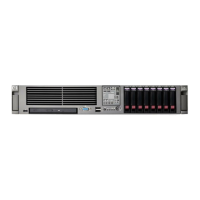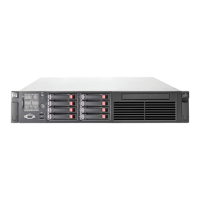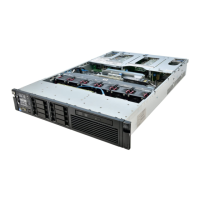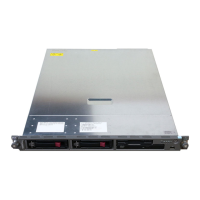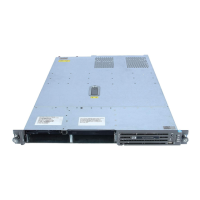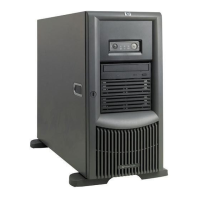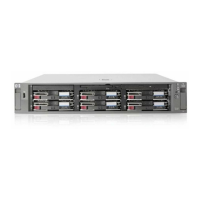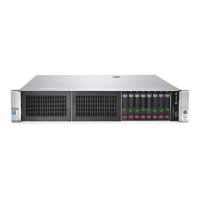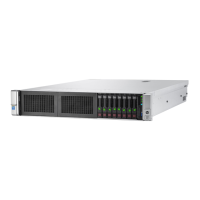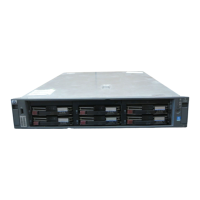
Do you have a question about the HP ProLiant DL380 Generation 4 and is the answer not in the manual?
| Maximum Processors | 2 |
|---|---|
| Chipset | Intel E7520 |
| Memory Slots | 8 |
| Form Factor | 2U Rack |
| Processor | Intel Xeon (various models) |
| Memory Type | DDR2 SDRAM |
| Storage | SAS/SATA HDD |
| Drive Bays | Up to 8 LFF or 16 SFF |
| RAID Support | RAID 0, 1, 5 |
| Network Interface | Embedded Gigabit Ethernet |
| Operating System Support | Microsoft Windows Server, Red Hat Enterprise Linux, SUSE Linux Enterprise Server |
| Expansion Slots | 3 PCI-X, 3 PCI Express |
| Power Supply | Redundant Power Supplies optional |
Identifies physical components on the server's front panel, including bays and ports.
Explains the function and status of front panel indicator lights and control buttons.
Identifies physical components on the server's rear panel, including slots and connectors.
Explains the function and status of rear panel indicator lights and buttons.
Details major components and connectors on the server's system board.
Identifies components of the SCSI and SAS backplanes.
Describes system board, backplane LEDs, and their combinations for status indication.
Explains LEDs for hot-plug SCSI and SAS hard drives and their status combinations.
Details LED status for PCI Hot Plug slots and riser cage.
Covers internal PCI Hot Plug LEDs, fan LEDs, power converter, and cache LEDs.
Provides instructions on how to turn on the server.
Details the procedure for safely shutting down the server.
Explains how to extend the server from its rack mounting.
Provides steps for removing the server's access panel.
Provides steps for reinstalling the server's access panel.
Guides on how to access the server's rear panel for maintenance.
Information on HP Care Pack services for server setup and support.
Guidance on planning server rack installations and airflow.
Requirements for the ideal environmental conditions for server operation.
Specifies acceptable operating and storage temperature ranges.
Details electrical requirements and safety precautions for server power.
Outlines the necessary electrical grounding procedures for the server.
Safety warnings and precautions related to rack installation and stability.
Lists items typically found in the server's shipping carton.
General guidance on installing hardware options before server initialization.
Step-by-step instructions for mounting the server in a rack.
Procedures for installing a supported operating system on the server.
Steps for powering on and initial configuration of the server.
Information on how to register the server with HP.
General advice for installing multiple hardware options.
Instructions for installing or replacing server processors.
Guidance on expanding server memory with DIMMs.
Rules and guidelines for populating DIMM slots.
Information on configuring online spare memory for enhanced availability.
Step-by-step procedure for installing memory modules (DIMMs).
Guidelines for adding or replacing hot-plug SCSI hard drives.
Explains SCSI ID management for hard drives.
Procedure for removing a blank filler from a SCSI drive bay.
Steps to install a hot-plug SCSI hard drive into the server.
Steps to remove a hot-plug SCSI hard drive from the server.
Guidelines for adding or replacing hot-plug SAS hard drives.
Information on numbering and bay assignments for SAS drives.
Steps to install a hot-plug SAS hard drive into the server.
Steps to remove a hot-plug SAS hard drive from the server.
Procedure for installing a diskette drive into the server.
Instructions for installing a hot-plug tape drive.
Details on installing redundant hot-plug fans for cooling.
Prerequisites and requirements for installing redundant hot-plug fans.
Illustrates and identifies the server's hot-plug fans.
Step-by-step guide to installing redundant hot-plug fans.
Procedures for removing and replacing the front fan bracket.
Information on installing the battery-backed write cache module.
Instructions for installing a redundant hot-plug AC power supply.
Overview of PCI riser cage options and compatibility.
Step-by-step guide for installing the PCI riser cage.
Step-by-step guide for removing the PCI riser cage.
Information on supported PCI, PCI-X, and PCI Express expansion boards.
Procedure to remove the cover for expansion slot 1.
Procedure to remove covers for expansion slots 2 and 3.
Steps to install a standard expansion board.
Procedures for installing PCI expansion boards with hot-plug capability.
Guidelines for cabling SAS hard drives and backplanes.
Guidelines for cabling SCSI hard drives and backplanes.
Instructions for connecting USB devices and cables.
Details on connecting DVD/CD-ROM drives.
Instructions for connecting the diskette drive.
Guide for connecting the power button and LED cables.
Cabling for the optional PCI Hot Plug backplane.
Instructions for connecting the RILOE II remote management module.
Details on internal power cable connections.
Cabling configuration for embedded simplex SCSI.
Cabling configuration for embedded duplex SCSI.
Cabling configuration for optional PCI simplex SCSI.
Cabling configuration for optional PCI duplex SCSI.
Cabling configurations for mixed duplex SCSI setups.
Procedures for installing the SCSI terminator board.
Procedures for removing the SCSI terminator board.
Guidelines for connecting external storage devices.
Overview of tools for server setup and configuration.
Information about HP's SmartStart software for server deployment.
Details on the SmartStart Scripting Toolkit for automated deployments.
Utility for replicating server hardware configurations across multiple systems.
Embedded utility for configuring server hardware settings.
Guidance on navigating and using the ROM-Based Setup Utility.
Describes the automatic system configuration upon first boot.
Steps to configure online spare memory for increased availability.
Information about the browser-based utility for array management.
Utility for creating logical drives and RAID arrays before OS install.
Software for rapid, high-volume server deployments.
Procedure to re-enter system serial and product IDs after board replacement.
Overview of server management utilities.
Explains the ASR feature for automatic system restarts.
Utility for upgrading system firmware (BIOS).
Tool for efficiently upgrading system or controller ROM images.
Information on the RILOE subsystem for remote manageability.
Utility for firmware downloads and device verification.
Information on agents for fault, performance, and configuration management.
Web-based application for server administration tasks.
Information on safely upgrading server ROM with redundant support.
Procedures to access and select redundant ROM versions.
Utility for configuring and setting up the iLO interface.
Details on standard and legacy USB support for the server.
Overview of diagnostic utilities for server troubleshooting.
Utility to gather critical hardware and software information.
Tool for collecting array controller information and detecting problems.
Proactive server management tool for diagnostics and troubleshooting.
Records and stores server events for easy viewing.
Information on maintaining system software and drivers.
Guidance on installing and updating server drivers.
OS-specific packages of tools and utilities for HP servers.
Bundles of optimized drivers, utilities, and agents for ProLiant servers.
Information on supported operating system versions.
Notifications regarding upcoming hardware and software changes.
Search engine for finding HP product information.
Information on HP Care Pack services for extended warranty and support.
Guidance on resources for resolving common server problems.
Steps to quickly diagnose and troubleshoot server issues.
Safety precautions to be aware of before troubleshooting.
Explains symbols indicating hazardous conditions on equipment.
General warnings and cautions related to equipment handling and repair.
Steps to prepare the server for diagnostic procedures.
Information to collect before troubleshooting a server problem.
Information on viewing latest service notifications from HP.
Actions to take for troubleshooting issues related to loose connections.
General guidance on troubleshooting processes and available flowcharts.
Flowchart to initiate the server diagnostic process.
A generic flowchart for troubleshooting unspecified server problems.
Flowchart for diagnosing issues when the server does not power on.
Flowchart for troubleshooting issues related to Power-On Self Test (POST).
Flowchart for diagnosing problems with the operating system boot process.
Flowchart for identifying and diagnosing server fault indicators.
Information on the product's unique regulatory model number.
FCC compliance statement for Class A digital devices.
FCC compliance statement regarding device operation and interference.
FCC notification about unauthorized device modifications.
Requirements for using shielded cables for FCC compliance.
Canadian compliance statement for Class A digital apparatus.
Compliance statement with EU directives for low voltage and EMC.
Instructions for proper disposal of electronic waste in the EU.
Japanese regulatory compliance information.
Taiwan's Bureau of Standards, Metrology and Inspection notice.
Korean compliance statement for Class A digital apparatus.
Compliance information for laser products, including safety warnings.
Taiwan EPA notice regarding battery recovery marks.
Specific statement regarding power cords for Japan.
Precautions to avoid damaging system components with static electricity.
Various methods for properly grounding electrostatic-sensitive parts.
Technical specifications including dimensions, weight, and input requirements.
Details operating and storage environmental parameters like temperature and humidity.
Information to have ready before contacting HP support.
Ways to find HP authorized resellers and technical support.
Information on HP's program for self-service replacement parts.
